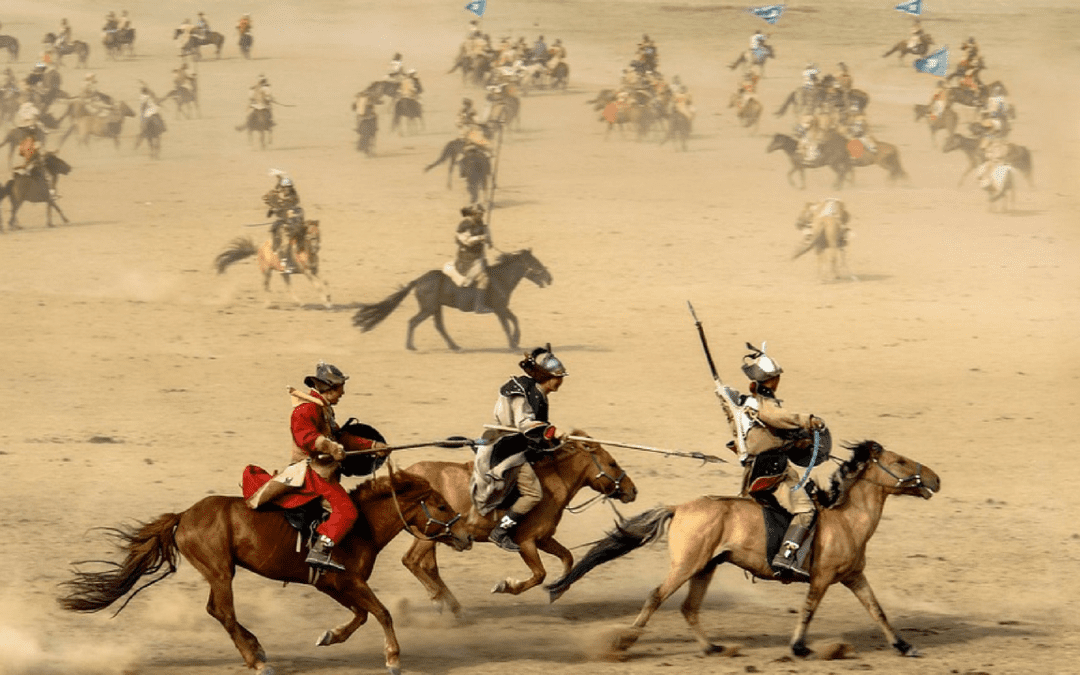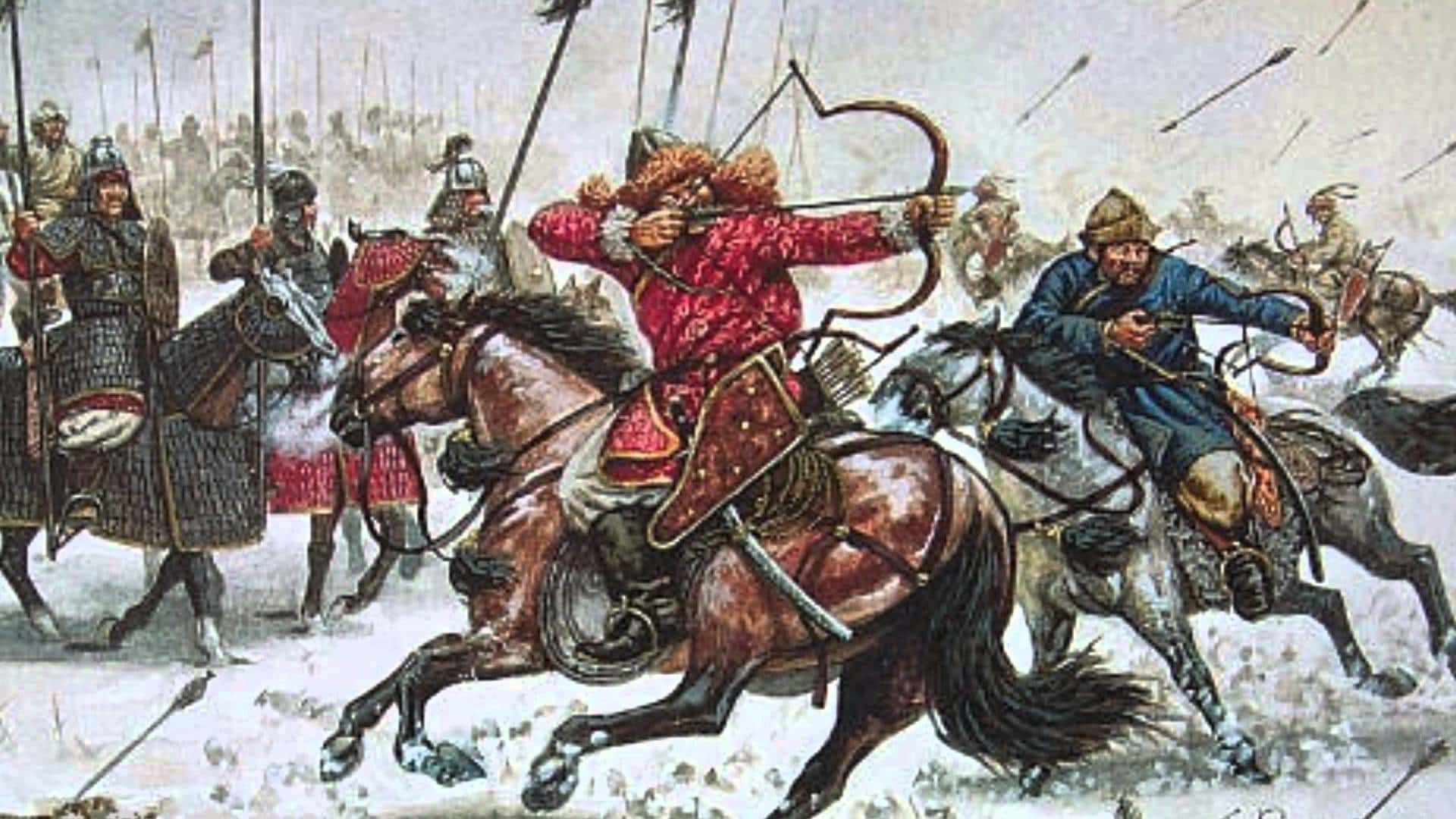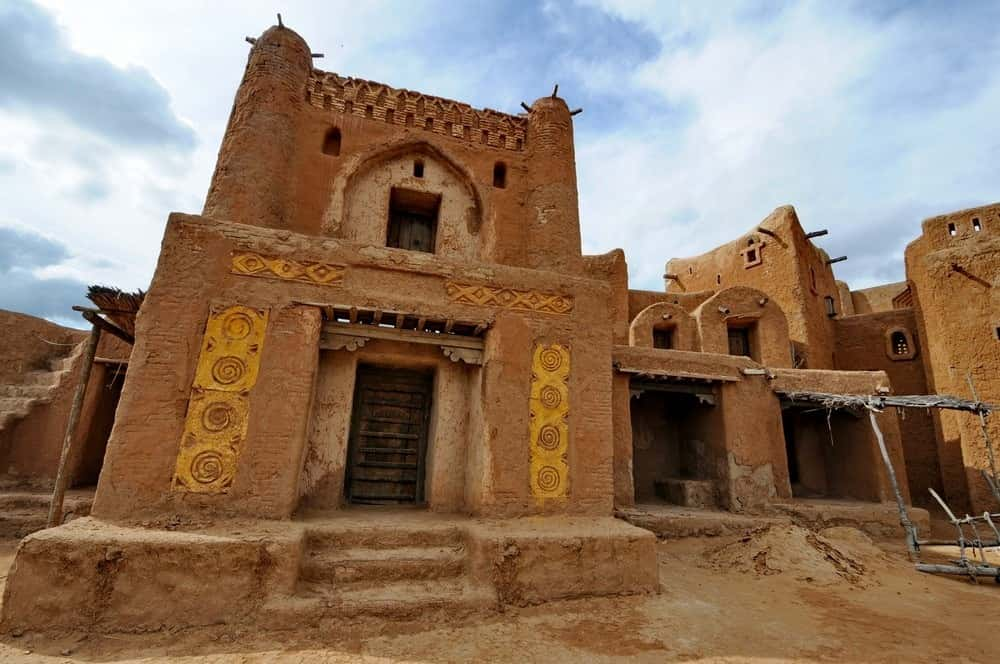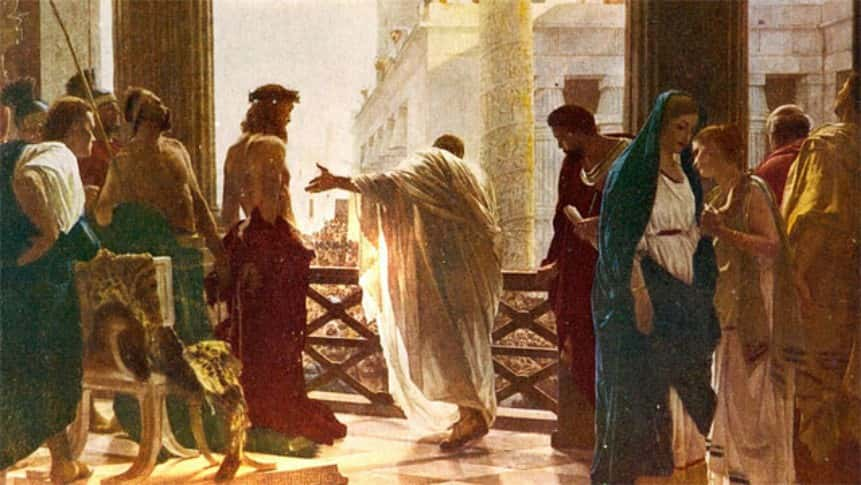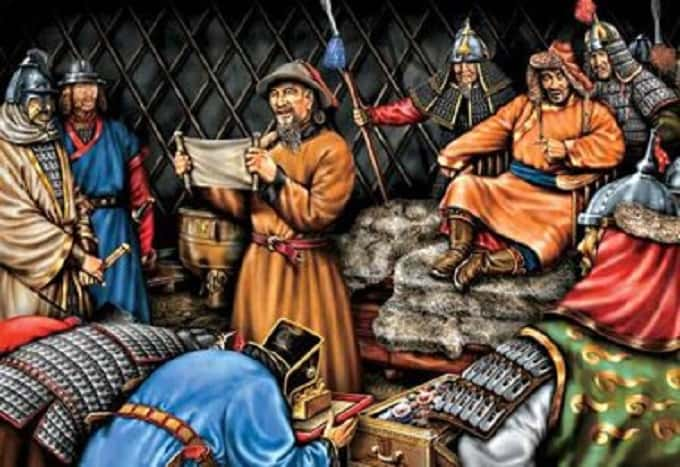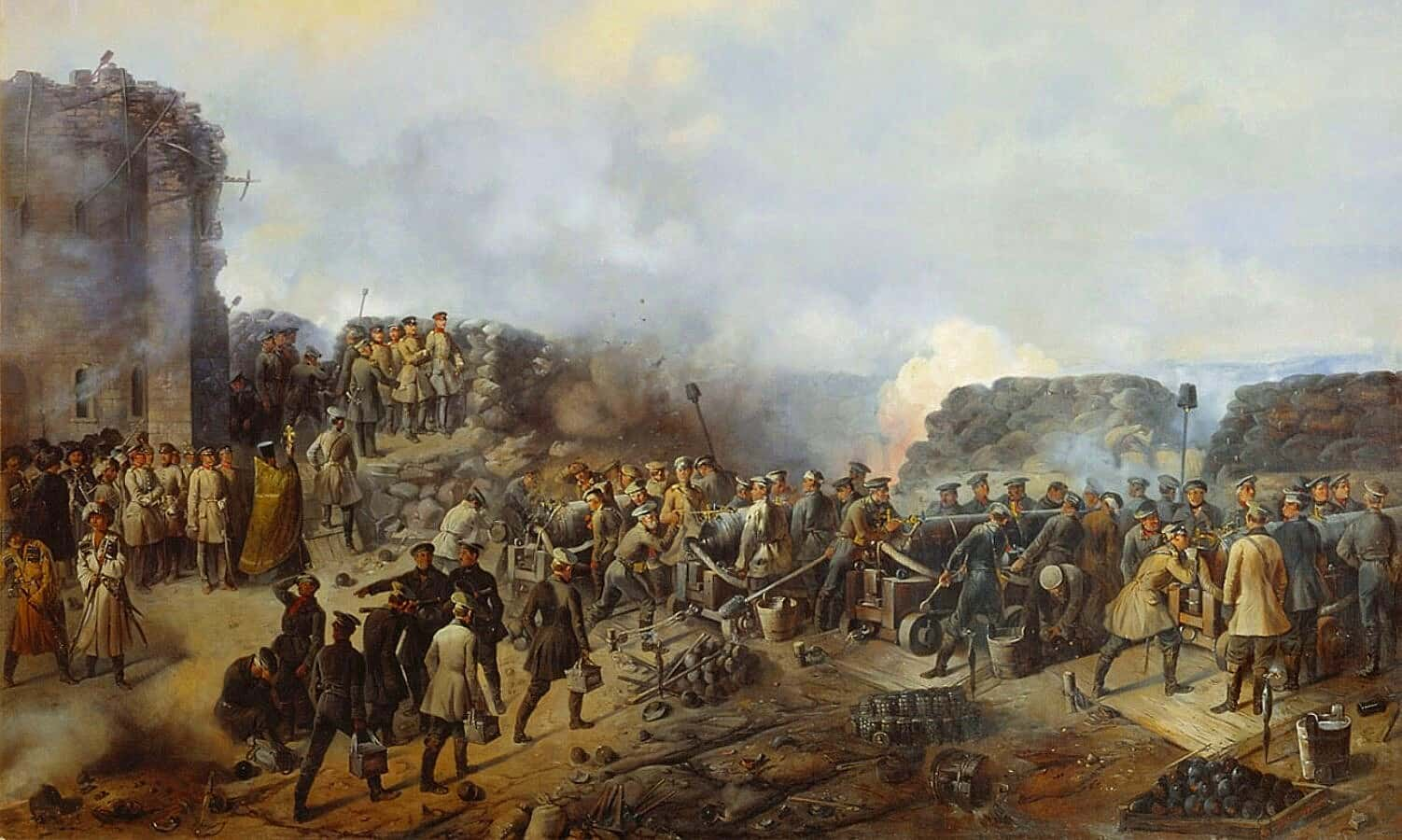Most people know about Genghis Khan and the Mongol Empire he created, but as with other conquerors like Atilla the Hun or Alexander the Great, Genghis Khan’s empire didn’t die with him. One aspect of the Mongol Empire which had a particularly lasting impression on history was the Golden Horde, a massive military and political entity which dominated Eurasia for centuries. Read on for 43 facts about the Golden Horde—with a name as awesome as that, need I say anymore?
43. As Good as Gold
There’s no sure evidence as to how the Golden Horde got its name. The most prevalent theory is that it was named after the gold-colored tents that the Mongols used. Another theory is that it was a reference to the immense wealth that they gained. Whoever it was, kudos on your naming abilities.
42. Sorry, I Don’t Speak Mongolian
A third theory about the name states that the words “golden” and “horde” are mistranslations of the Mongolian words for “central camp.” That it would be mistranslated into such an amazing name in English seems a tad coincidental though (not to mention extremely disappointing), so we’re sticking with the tent explanation.
41. Land Taxes Get Us Every Time
In 1310, the Golden Horde controlled 2.3 million square miles of territory. That’s larger than Alexander the Great’s empire.
40. Find it on the Map
This empire was mostly centered around Eastern Europe, stretching from the Urals to the Danube, the Black Sea, and into Siberia.
39. Hindsight is 20/20
Despite the awesome name, the Golden Horde wasn’t known as the Golden Horde in historical records until the 16th century. I can only assume they were known as something equally cool like “The Shining Legion of Death and Doom.”
38. Two More Colors and You’d Have a Power Rangers Team!
Historians call the divisions of troops on the Golden Horde’s flanks the White Horde and the Blue Horde, but sources conflict as to whether the left flank was White and the right was Blue, or vice versa (does it really matter?). Just like with the term “Golden” however, there’s no evidence that the Mongols themselves called their units by color.

37. International Inheritance
The Golden Horde didn’t even exist while Genghis Khan was alive—it was only founded when he died. His four sons divided the empire into individual parts, but all the parts were still under the command of the Great Khan.
 youtube
youtube
36. Who’s Leading the Pink Horde, Then?
The territory occupied by the Golden Horde would have gone to Genghis Khan’s son, Jochi, but Jochi died just before his father did. Instead, Jochi’s two sons, Batu and Orda, took command of the Blue Horde and White Horde respectively.
35. It’s Not a Race Guys!
In 1235, Batu Khan joined forces with Subutai, one of Genghis’s top generals (and one of the most successful generals who ever lived, according to some historians). Together, they rode west and invaded Bulgaria. We’d like to say it was a decades long campaign, but this is an article about facts, not Bulgarian nationalism. It took those two just one month to conquer the region.
34. If It Stands, We Can Destroy It
Batu Khan and Subutai soon turned their attention (and their army of 35,000 horsemen) towards Kievan Rus (in modern-day Ukraine and Russia). From 1237-1240 AD, the Golden Horde blazed across the countryside and destroyed all opposition before them.
33. At Least the Gravediggers Had a Field Day
The invasion of Kievan Rus, in true Mongol style, left a bloody body count in its wake. It’s been determined that 500,000 people lost their lives to the Mongols in this campaign. That’s about 7% of the Kieven Rus's population at that time.
32. I Wonder if They Liked Tatar Steak
As the Mongols conquered their way across Asia under Genghis Khan, many tribes joined the Great Khan’s banners. Among these were the Tatars, a Turkic people. The Mongols and Tatars formed a hybrid culture, and eventually the Golden Horde was considered as much a Turkic entity as a Mongol one.
31. Alas, Poor Yuri
Grand Prince Yuri II of Rus had absolutely no luck dealing with the Golden Horde. First, they invaded his lands and burned cities such as Moscow to the ground. Then, they besieged his capital city of Vladimir. Yuri hastily rallied an army of mostly infantry to relieve the city before the Mongols took it. However, he was too late, and before he knew it, he found himself surrounded by some of the most skilled horsemen in human history. In the Battle of Sit River, Yuri’s force was annihilated, and he died while trying to retreat.
30. Can We Call Them Sr. and Jr.?
The Golden Horde had its capital city at Sarai. However, the same name was applied to two different cities in Mongol history. The first city, Old Sarai, was set up by Batu Khan near the Akhtuba River. New Sarai stood near modern-day Kolobovka, Russia and was hailed by travellers as a city of great beauty and thriving activity. They were two of the biggest cities of the medieval world, stated to have populations at over half a million people each.
29. The Kingmaker
When Güyük Khan became Great Khan in 1246, it was without the direct support of Genghis' son Batu Khan. Batu had actually delayed the election of the Great Khan for a few years by not going all the way back to Mongolia, claiming old age. This was just asking for trouble, and Güyük frequently requested that Batu Khan visit him and pay homage. Batu finally agreed, but when he returned to Mongolia, he did so with an enormous army at his back. Miraculously, a bloody conflict was avoided when Güyük died of gout complications while Batu was traveling back. Batu threw his support behind another cousin, Möngke, to become the next Great Khan in 1251. Batu enjoyed the height of his power during this time, since his friendship with Möngke was the glue which kept the Mongols from going to war against each other.
28. Survive Endless Battle, Drop Like Flies in Peacetime
Batu Khan eventually died in 1256, and was replaced by his son, Sartaq. However, Sartaq himself died a year after his father (probably due to poison, but Sherlock Holmes wasn’t around to figure it out for sure). Eventually Batu’s brother, Berke, took charge of the Blue Horde in 1257.
27. So Much for Family
After the deaths of Batu, and later Möngke Khan in 1259, a succession crisis broke out between two of Genghis Khan’s grandsons, the brothers Kublai Khan and Ariq Böke. Despite the Golden Horde initially siding with Böke, Kublai Khan became the Great Khan just in time for Marco Polo to show up.
26. Let’s Try This Out for a Bit
Berke Khan ultimately made a lasting impact on the Golden Horde by introducing Islam to the Mongols for the first time. The Golden Horde would eventually make Islam their state religion during the rule of Uzbek Khan, who was himself a devout Muslim (more on him later, though).
25. Peaceful Mongols
While the family of Batu Khan and the Blue Horde became deeply involved in the conflicts of the Great Khan’s succession, the White Horde was far more indifferent to the whole thing. Köchü Khan was the grandson of Orda Khan, the White Horde’s original leader, and he maintained an era of peace. Even Marco Polo wrote about Köchü’s policy of peace, prosperity for his people, and his friendly relationship with Kublai Khan and the Yuan dynasty of China.
 Mongols China and the Silk Road
Mongols China and the Silk Road
24. Them Neighbors, I Tell Ya
While the Blue Horde initially stayed out the conflict between Kublai Khan and Ariq Böke, Berke eventually found himself in a war with Hulagu Khan’s family, which controlled the south-western region of the Mongol Empire, known as the Ilkhanate. Even the Great Khan took sides during the war. After a couple years of bloody conflict, both Berke and Hulagu Khan were dead, and Kublai Khan had lost control of entire western regions of the Mongol Empire. The Berke-Hulagu War was only the second open war between the Mongols, but it certainly wasn’t the last.
23. No Need to Thank Us, Russia
The Golden Horde was instrumental in shaping Russian history. For one thing, they kept people from developing the forests and steppes from Moscow to the Black Sea known as the Wild Fields. During the 14th century, individuals and small groups of nomadic people would venture into the Wild Fields to make a living. Eventually they stuck around and formed bastions of defence against raiders venturing into Russian lands. These people became known as the Cossacks, and their entire way of life was initially a response to the Mongol-Tatars of the Golden Horde.
22. Wait, How Many of Us are Mongols?
While it varied over the centuries, the Golden Horde was comprised of more than just Mongol and Turkic people. At one point or another, they also included the Slavs and the Scythians.
21. That’s No Yoke
The Golden Horde spent more than two centuries raiding and pillaging areas of Russia. Cities were razed, slaves were taken, and resistance was crushed. This domination by the Golden Horde was known as the Tatar-Mongol Yoke over Russia.
20. Great Foreign Policy
One of the men who truly represented the Tatar-Mongol Yoke over Russia was Dyuden, the brother of Tokhta Khan (both of whom were great grandsons of Batu Khan). As a general in Tokhta Khan’s army, Dyuden invaded Russian territory in 1293, overwhelming fourteen towns and cities, including Moscow. Ironically, Dyuden’s son, Shevkal, later served Uzbek Khan as an ambassador. Doesn't sound like diplomacy was exactly in his genes.
19. Blood Business
The Golden Horde’s Turkic connection extended beyond their shared heritage and culture. For centuries, they conducted a slave trade with the Middle East and the Ottoman Empire. Crimea became the center of the Tatar slave market, where it was said that slaves made up 75% of the population.
18. What was Their Military Budget?
The raids of the Tatar-Mongol Yoke became such a regular occurrence that it became expected for Moscow to raise 65,000 troops every spring to set up a defensive line against the Golden Horde.
17. Will it Never End?
Even after the Golden Horde had broken apart, the independent kingdoms it spawned remained the scourges of the Russians. In the first half of the 16th century alone, the Kazan Khans launched 40 major raids against Russian territory. Just leave them alone!
16. A Golden Khan for a Golden Horde
Uzbek Khan, also named Ozbeg or Uzbeg, or Sultan Oz Beg, was the longest-reigning khan of the Golden Horde, ruling from 1313 to 1341 AD. That’s an impressive twenty-eight years (khans didn’t have great retirement benefits). Taking over from his uncle, Tokhta, Uzbek ruled the Golden Horde during its most powerful period. He was said to command 300,000 men, one of the largest armies of the time.
15. Praise from the Pope?
Allegedly, Uzbek Khan was an uncommonly benevolent leader. He was welcoming and fair to all of his people, regardless of their religious faith. Anyone who displayed religious intolerance or violence against others out of bigotry risked the death penalty under Uzbek’s rule. Pope John XXII even sent Uzbek Khan a letter thanking him for his benevolent treatment of Christians. Didn’t expect that, did ya?
14. All Good Things…
As the 14th century went on, the power of the Golden Horde began to splinter as different factions fought to either strike out on their own or to take control of the whole horde. While Urus Khan of the White Horde managed to hold things together for a bit of time, the Horde found a serious enemy in one of their own Mongol peers: the conqueror known to history as Timu, or Tamerlane.
13. … Must End
In the 1390s, Tamerlane overran the Golden Horde’s territories since their leader at the time, Tokhtamysh, was one of Tamerlane’s biggest rivals. Tamerlane not only defeated his foes, but he destroyed the city of Sarai, crippling the Golden Horde for the rest of its days.
12. One Last Gasp
The remnants of Tatar-Mongol power rose up in 1571, in the middle of the Russo-Crimean War. An army of over 120,000 Crimeans led by Devlet Giray Khan invaded Russian territory. Although they succeeded in burning Moscow and taking more than 150,000 Russians as slaves, this was the last straw for Russia. The following year, this huge army of Mongol-Tatars was confronted by Mikhail Vorotynsky, who led 25,000 Russians into battle. Presumably after the Mongols had a moment to laugh at their enemies, they were doubtless surprised to be utterly crushed by the Russian Prince and his smaller force. It was the ultimate death knell for the Khans, and it made Vorotynsky a hero to his people. Unfortunately, the only information we have on Vorotynsky’s end is that he was suspected of treason by his Tsar, Ivan the Terrible, and Ivan lived up to his name by torturing the war hero to death.
11. Warriors, Raiders… Tax Collectors?
The Mongols of the Golden Horde didn’t mess around when it came to subjugating people and demanding tributes from them. During the height of their rule, the Golden Horde would take a census of all the people who owed them tribute. This occurred multiple times in Russian history. Can you imagine the paperwork?
10. From Gold to Just Great
In the 15th century, the Golden Horde began to break apart into individual regions known as khanates. The Kazan Khanate split off in 1438, followed by the Crimean Khanate in 1441, and the Astrakhan Khanate in 1466. The remaining territory, consisting of the steppe around Sarai, was held by what was left of the Golden Horde, now known as the Great Horde.
9. Great as Gold? I Think Not
The Great Horde was named rather inaccurately. While the Golden Horde had lasted centuries, the Great Horde barely survived to the end of the 15th century. Most of its people and horses were absorbed into the Crimean Khanate in 1502 AD.
8. Ripe Old Age
Although the Golden Horde had ceased to exist, the remaining kingdoms that sprang from its remnants managed to stick around for a very long time. The Crimean Khanate endured until 1783, when it was annexed by the Russian leader Catherine the Great. The Kazakh Khanate, meanwhile, lasted until 1847. Even after its demise, its territory later became the Republic of Kazakhstan. Which means the Khan dynasty is connected to Borat. If that’s not a sign of their downfall, I don’t know what is.
7. How Many Accountants does that Require?
At one point or another in history, the Golden Horde exacted tolls from a huge variety of peoples, including the Georgians, Armenians, Crimean Greeks, Goths, and Alans, to name a few. The Horde kept them paying their taxes by being utterly ruthless towards any opposition, along with the occasional raid to keep them on their toes. No word on if a raid was tax-deductible in those days.
6. Flip a Coin
Though people today may think of the Golden Horde as a bunch of savage wildmen, probably due to the Western bias in our histories, they actually mined and minted their own coins. These carried images of their leaders as an homage, not unlike many other ancient civilizations.
5. It Pays to Learn Things in School!
Most sources we have of the Golden Horde aren’t Mongolian. We take many of the information we know about them from Russian sources, some of whom were writing at least two centuries after the events. This is perhaps because most Mongols were illiterate and had no time for reading, but could also be explained by the fact that nearly all Mongolian texts were being translated into other languages for various part of the empire, and these translated editions are all that survive.
4. That Was Us?!
In 1347, a city in Crimea owned by the Genoese named Kaffa was under siege by the Golden Horde. During the siege, several of the Horde’s forces began dying of a foul disease. Seeking to use this as an advantage, the Mongols began catapulting the diseased bodies of the dead into the city. Many scholars believe that this was how the Black Death first came to Europe, as the Genoese brought the disease with them when they fled Kaffa and headed west for havens such as Sicily. This means that the Mongols, between the Black Death and their regular conquering, have maybe the highest death count of any civilization in world history.
3. Brings a Sword to a Gun Fight
The Russians finally overthrew the Tatar Yoke once and for all in 1480 at the Great Stand on the Ugra river. By then, the Golden Horde had become the Great Horde, led by a man named Akhmat. They expected their latest raid into Russia to go as usual, but instead they were stopped at the river, facing a large army of Russians led by Ivan Molodoy, the son of Ivan III. Some historians recorded that the Russians were armed with firearms, of which the Mongols had none. But whether they had those kinds of weapons or not, the standoff led to Akhmat pulling back and leaving without a fight. While it wasn’t the end of Mongol attacks on Russia, the stand off has been hailed by Russian historians as a watershed moment which proved that Tatar rule over Russian lands was over.
2. Sinister Statistics
The people of modern-day Hungary suffered greatly from their interactions with the Golden Horde. Over the course of the many years of conflict, it’s been estimated that up to half of Hungary’s entire population became casualties of the Golden Horde.
 youtube
youtube
1. One Little Muscle Changes History
In 1241, the Golden Horde were poised to stream into Western Europe and ravage it like they’d done with all their other enemies' lands. Considering how well the Mongols had fared against the Chinese, the Persians, and the Russians, there was seemingly no way that pitiful little Medieval Europe would offer any kind of worthy resistance. Yet, the Mongols were in the middle of besieging Vienna when they suddenly ceased their hostilities and left for the Far East. Why? They had gotten word that Ögedei, the Great Khan, had died. Mongolian tradition dictated that the Mongols had to reconvene for the choice of the next Khan. Meanwhile, Western Europe was spared the utter devastation that always came with a Mongol invasion, giving them the breathing space to develop while the Mongols subjected much of the formerly great Asian empires under their heel. All because one man had a heart attack. Centuries of history changed by a single organ’s failure to keep beating. It’s too profound for a final joke, honestly.
Sources: 1, 2, 3, 4, 5, 6, 7, 8, 9, 10, 11, 12, 13, 14, 15, 16, 17



